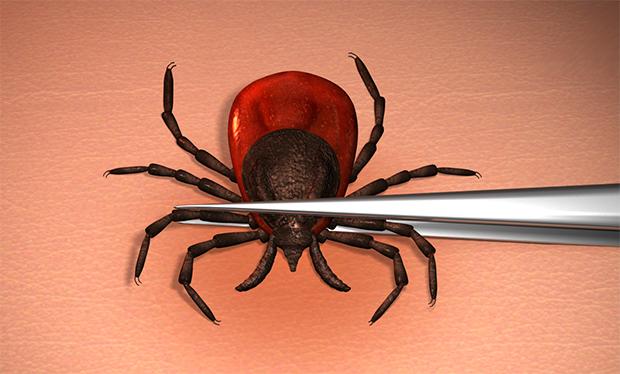About ticks
Ticks are tiny bugs most likely found in shady, damp, brushy, wooded, or grassy areas (especially in tall grass), including your own backyard.
Different kinds of ticks feed on the blood of mammals (including people, dogs, cats, deer, and mice), birds, or reptiles (snakes and turtles, for example). In Massachusetts, certain kinds of ticks can bite you and spread diseases like Lyme disease, babesiosis, anaplasmosis, tularemia, Rocky Mountain spotted fever, Borrelia miyamotoi, and Powassan virus.
Ticks do not fly or jump. They attach to animals or people that come into direct contact with them. Deer ticks and dog ticks are found throughout Massachusetts; Lone Star ticks are also found in some places in Massachusetts.
Black-legged Ticks
Black-legged ticks, sometimes called deer ticks, are responsible for spreading Lyme disease, babesiosis, anaplasmosis, Borrelia miyamotoi, and Powassan virus. Both nymph (young) and adult black-legged ticks will bite humans. The highest risk of being bitten by this kind of tick occurs throughout the spring, summer and fall seasons. However, adults can also be out searching for a host any time winter temperatures are above freezing. Black-legged tick nymphs are the size of a poppy seed and adults are the size of a sesame seed.
Dog Ticks
Dog ticks are responsible for spreading Rocky Mountain spotted fever and certain types of tularemia. In general, only the adult dog tick will bite humans. The highest risk of being bitten by a dog tick occurs during the spring and summer seasons. Adult dog ticks are about the size of a watermelon seed.
Lone Star Ticks
Lone star ticks are not a significant source of human illness in Massachusetts at this time but are capable of spreading tularemia, ehrlichiosis and southern tick-associated rash illness (STARI). Lone star tick saliva can be irritating but redness and discomfort at a bite site does not necessarily indicate any infection. Exposure to Lone Star tick saliva has been shown to cause an allergy to red meat in some people. The nymph and adult females most frequently bite humans.
Prevention tips
Personal protection against ticks
One of the most important things you can do is check yourself for ticks once a day. Favorite places ticks like to go on your body include areas between the toes, back of the knees, groin, armpits, and neck, along the hairline, and behind the ears. Remember to check your children and pets, too. Remove any attached ticks as soon as possible.
- Check yourself, your children and your pets for ticks after coming inside:
- Inside and behind the ears
- Along your hairline
- Back of your neck
- Armpits
- Groin
- Legs
- Behind your knees
- Between your toes
- Ticks are tiny, so look for new "freckles"
- If you find a tick attached to your skin, don't panic. Use a pair of fine point tweezers to grip the tick as close to the skin as possible and pull straight out with steady pressure.
- You should not apply kerosene, petroleum jelly, nail polish, or a hot match tip to remove the tick. These measures are not effective and may result in injury.
- Circle the calendar date and note where on the body the tick was removed. You may want to save the tick for identification.
- Your physician may choose to treat you following a deer tick bite. Notify your health care provider if you have been bitten by a deer tick or if you develop a rash or other signs of illness following a tick bite
- Talk to your doctor if you develop a rash where you were bitten or experience symptoms such as fever, headache, fatigue, or sore and aching muscles.
- When going outside to an area likely to have ticks:
- Stick to main pathways and the center of trails when hiking.
- Wear a light-colored, long-sleeved shirt with long pants and tuck your pants into your socks. This may be difficult to do when the weather is hot, but it will help keep ticks away from your skin and make it easier to spot a tick on your clothing.
- Use bug repellents. Repellents that contain DEET can be used on your exposed skin. Permethrin is a product that can be used on your clothes. Always follow the product instructions and use repellents with no more than 30-35% DEET on adults and 10-15% DEET on children. Never use insect repellents on infants. See our fact sheet on Tick Repellents.
- Talk to your veterinarian about the best ways to protect your pets and livestock from ticks
Tick-borne disease fact sheets
You can view fact sheets about various tick-borne diseases:
- Lyme Disease
- Anaplasmosis (HGA)
- Babesiosis
- Borrelia miyamotoi
- Powassan virus
- Rocky Mountain Spotted Fever
- Tularemia
Additional resources
- How to Do a Tick Check PDF (DOC)
- Tick Identification and Testing Services
- Tick Repellents
- Tularemia Update for Landscapers PDF (DOC)
- Preventing Disease Spread by Ticks PDF (DOC)
- Haitian Creole - Prevni Maladi Tik Simaye PDF (DOC)
- Portuguese - Prevenção de Doenças Transmitidas por Carrapatos/Carraças PDF (DOC)
- Spanish - Cómo prevenir las enfermedades transmitidas por las garrapatas PDF (DOC)
- Gardening Tips - Don't let the bugs bite! PDF (DOC)

